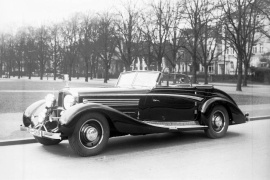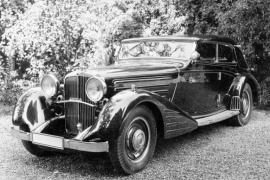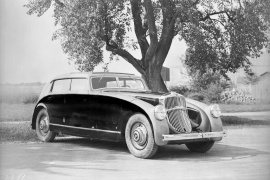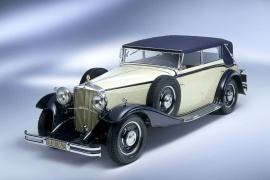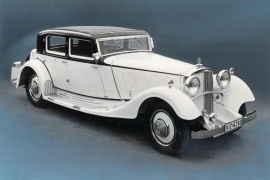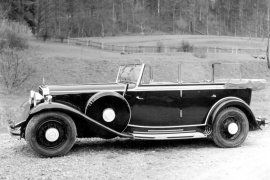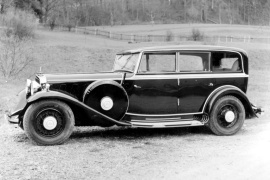MAYBACH Typ Zeppelin Models/Series Timeline, Specifications & Photos
First production year: 1930
Engines: Gasoline
The German automaker tried to revive its luxury car production when it introduced the V12-powered Zeppelin in 1938, which was available with various bodyworks, including a two-seat open-top vehicle.
Maybach trusted the Spohn company to create the bodyworks for about 80% of the vehicles produced by the German automaker. Thus, the Sport-Cabriolet version, which was based on the short-wheelbase version of the DS8, left the factory only as a rolling chassis and was finished by the exclusive German coachbuilder.
Spohn understood the importance of aerodynamics and tried to create vehicles that could travel faster than most other cars on the market. That's why when it penned the Sport-Cabriolet bodywork, it made long, curved fenders with small wheel arches. Thus, there a smaller air quantity was trapped inside the wheel wells. In addition, the pinned-out radiator that was surrounded by a thick chromed rim offered a luxurious image of the vehicle. Spohn installed a short and tilted, two-piece windshield for the cabin. At the back, the sloped-down bodywork covered the trunk.
Inside the car, the dashboard was covered in wood. The six analog dials on the panel were in silver circles. The big, four-spoke steering wheel hosted the air-fuel mixture ratio adjustment lever. Occupants were pampered by the large seats of the vehicle.
The DS8's underpinnings were based on a lightweight chassis that supported the entire construction. Under the hood, the eight-liter V12 powerplant was paired to a Maybach-specific eight-speed sequential gearbox. In fact, it was a 4-speed transmission with a sliding gearbox and a separate overdrive, which provided a total of eight forward speeds forward and vacuum-assisted shifting. The DS8 also featured a novel servo-assisted pneumatic brake developed by Bosch-Dewandre.
MAYBACH Typ Zeppelin Doppel-Sechs 8 Liter (DS 8) Sport-Cabriolet 8.0 V12
Maybach installed the V12 engines in the famous Zeppelin airships and it used the same powerplants to create engineering monuments on the road. And then, he asked Spohn to build the rest.
The Zeppelin name was used only for the most exclusive cars built by Maybach. In 1930, the German company unveiled at the Paris Automobile Salon the DS8. The exclusive (and highly expensive) Maybach limousine was ordered by kings, emperors, and very rich people. Soon, a convertible model was offered. But, as usual for those times, the bodywork was signed by Spohn coachbuilder. Spohn equipped around 80% of the Maybach chassis.
The large convertible was aerodynamically studied, to offer a smaller drag resistance. Hence the world “stromlinien” (streamlined). Even though the big radiator was like a brick wall in front of the car, the rest was streamlined. The front large fenders were extended in the back to the bottom of the rear fenders. The rear-hinged doors were cut so it allowed the extended fender to pass-through. The trunk was sloped and, when closed, it formed an aerodynamic shape.
Inside the car, the dashboard was covered in wood. The six analog dials on the panel were in silver circles. The big, four-spoke, steering wheel featured the air-fuel mixture ratio on a small lever. Even though the car featured four very large seats, the bench was mostly used for the luggage.
The lightweight chassis and the V12 engine were just part of the marvelous engineering surprise. The 8-speed gearbox was something different. In fact, it was a 4-speed gearbox with sliding-gearbox with a separate overdrive, which provided a total of eight forward speeds forward and vacuum-assisted shifting. The DS8 also featured a novel servo-assisted pneumatic brakes, developed by Bosch-Dewandre.
The Maybach engines were used in the Zeppelin dirigible. On those times, it was the most luxurious way of travel in the world. That is why the top of the range of Maybach cars wore the name Zeppelin.
Maybach produced more chassis than bodyworks. Most of the bodyworks were made by the Spohn builder. Its workshop was close to the Maybach factory from Friedrichshafen in Germany. It was a common practice on those times to have a custom-built bodywork.
The Stromlinien (Streamline) was an aerodynamically enhanced bodywork, shaped with some help of aviation engineers. On the front, the grille was pushed behind the front fenders and raked. The curves on the bodywork were like a flow, thus reducing the drag coefficient. The short greenhouse of the Maybach Zepellin Stromlinien was mandatory for a more streamlined bodywork since on those times the windshield was flat. The curved glass was not available. In the back, the abrupt slope was curved. On the left and right side of the back panel, there were two trunk spaces. The spare wheels were located behind locked panels to the rear of the front wheels. The car featured a central locking mechanism and the door handles were recessed into the door panels. Another interesting feature was the retractable front part of the roof.
Under the long hood, there was an 8-liter V12 engine that produced 200 hp. It was mated to a 5-speed gearbox with a system that allowed the engagement of the fifth gear without using the clutch.
MAYBACH Typ Zeppelin Doppel-Sechs 8 Liter (DS 8) Stromlinien 8.0 V12
After WWI, Maybach couldn't produce engines for the aircraft industry, and Karl Maybach continued his father's legacy and introduced the DS8 upscale model in 1931.
After Wilhelm Maybach died in 1929, his son took the lead of the exclusive automobile manufacturer. In just two years, he created a new range: the Doppel-Sechs 8. Since it was the top-of-the-line model offered by his company, he used the name Zeppelin on it.
With a weight that required a commercial driving license and larger dimensions than most luxury cars from that era, the Zeppelin DS8 Cabriolet was a vehicle built as a long-range tourer. It offered power, comfort, and styling at a price that only a few could afford it. Moreover, the governmental agencies didn't want to buy them. At the front, it featured the big, baroque-style fenders with an arched bar between them to support the big round headlights. A vertical, pinned-out radiator was specific for the brand. Unlike its limousine sibling, the Cabriolet featured different body panels, with a thick sloped-down line that started from the radiator and went all the way to the back of the car, surrounding the cabin. The canvas top was retractable and stored behind the last row of seats, above the trunk.
The carmaker installed a luxurious interior with leather upholstery, wood veneers, and chromed metallic parts for switches and gauges. It provided seating for up to eight passengers for the long-wheelbase version. Since the middle row was a fold-and-tumble type, they provided more legroom for the last row occupants. On the sides, Maybach installed removable window panels.
Under the long hood, there was an 8-liter V12 engine that produced 200 hp. It was mated to a 5-speed gearbox with a system that allowed the fifth gear's engagement without using the clutch.
Maybach produced the Zeppelin to be the most luxurious car in the world, but it couldn't find enough customers for it, and that resulted in meager sales.
Maybach was banned from producing engines for the aircraft industry after WWI, and the company turned its eyes toward the automotive industry, where it managed to build real masterpieces such as the Zeppelin Doppel-Sechs DS8. The name states that the car featured a double-six, eight-liter engine.
In 1931, Maybach introduced the Zeppelin Doppel-Sechs DS as an upper-range for the DS7. In those times, most luxury-car manufacturers supplied the vehicles as bare-chassis, and the customers could choose a coachbuilder to complete the vehicle. But Maybach offered the cars as completed vehicles, and the DS8 was a very large car by any standards. It weighed more than a regular driver's license allowed. At the front, it featured the big, baroque-style fenders with an arched bar between them to support the big round headlights. A vertical, pinned-out radiator was specific for the brand. Since the car featured a V-12 engine, the carmaker installed a tall and long engine compartment with six flaps on each side, which the driver could open or close to speed up the engine heating time or to keep it at an optimal temperature. The small, vertical windshield sported a pair of wipers mounted on its upper side.
Inside, Maybach installed a luxurious interior with leather upholstery, wood veneers, and chromed metallic parts for the switches and gauges. The carmaker produced a central locking system in an era where even the cranked windows were a luxury feature. Since Maybach offered the car for high-ranking officials, kings, and country rulers, it made it with a short or a long wheelbase.
Under the long hood, there was an 8-liter V12 engine that produced 200 hp. It was mated to a 5-speed gearbox with a system that allowed the fifth gear's engagement without using the clutch.
After WWI, Maybach was no longer allowed to build engines for aircraft, so it turned its attention toward the blooming car industry and made some of the most luxurious and exclusive vehicles from those times.
In 1930, the German carmaker introduced the Zeppelin Doppel-Sechs (double-six) luxury vehicle offered as a chassis-cab, a closed-body, or a convertible. The Maybach-Motorenbau badge was already known, and, despite the economic crisis of those times, the DS7 managed to find customers.
Karl Maybach designed the big vehicle with deep-pocket customers in mind. The result was a luxurious vehicle that sported the Zeppelin badge in front of the radiator, mounted on an arched bar supported by the front fenders between the headlights. A thick metallic bumper mounted on the chassis' endings gave the car a more robust appearance. But the front fenders also served as supports for the spare wheels, one on each side of the vehicle, flanking the engine compartment. In addition, Maybach offered the DS7 with two or three side windows, depending on the car's length. The shorter one was sportier, designed especially for the driver, not the passengers.
Inside, unlike the hard-top version, the Cabriolet featured four seats, with more room for the rear ones on the long-wheelbase version. This model was also made for officials, country rulers, or kings to stand up and salute their people if they wished so. Maybach took care of everything and used only expensive materials: leather, wood trims, and even gold.
Under the big, long hood, Maybach installed a seven-liter, naturally aspirated V12 engine. Even though it produced just a mere 150 PS (148 hp), that was enough to propel the car with 150 kph (93 mph). Moreover, unusually for those times, the car was fitted with power brakes in all corners.
Maybach was no longer allowed to produce engines for aviation, so it turned its attention to road vehicles and created some of the most luxurious cars from the '30s, such as the Zeppelin DS7.
The high-aristocracy still remembered the Zeppelin nameplate, and when they saw it on a car, they didn't need any further information. While the famous airships represented the most luxurious way to travel in the air, the road version couldn't be far from that. And it wasn't.
When Karl Maybach designed the car, it imagined it as a luxury salon on wheels. It offered it in two sizes, with three side windows and wide doors. At the front, the carmaker placed the badge Zeppelin between the fenders in front of the radiator. It was the success badge for those times. Its big headlights and very tall engine compartment offered a commanding view of the road ahead. The side-mounted spare wheels just added more glamour to the luxurious vehicle.
Inside, the carmaker installed up to six seats. There was a bench seat at the front and up to four seats in the back, with two jump seats where the passengers had to stay facing rearward. The most critical seats were on the last bench, where Maybach installed feet rests. As expected, the leather upholstery and expensive wood veneers were standard features.
Under the hood, Karl Maybach installed a V-12 engine. It was the second European vehicle to feature such a "monster" powerplant. It produced 150 hp, and that helped the 2.5-ton car to sprint quickly and provided better performances than most other luxury cars on the market.
